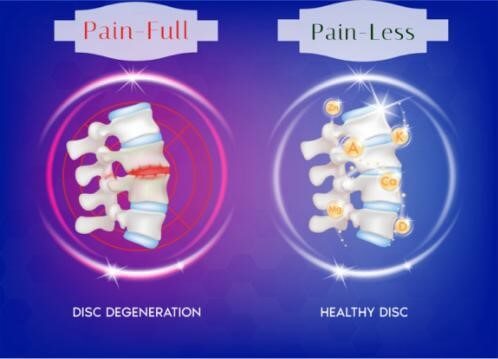
- Degenerative disc disease is a bit of a misnomer as its not actually a disease, rather its related to an aging spine is has discs that are breaking down or deteriorating. Often, this leads to severe pain in addition to causing a significant disruption in your ability to perform simple tasks of daily living. For many, this pain, numbness, or weakness radiates down the arm if in the cervical spine or the leg if in the lumbar spine
- The intervertebral discs that act as shock absorbers begin to wear out over time and thus don’t remain as functional as they once did. As unfortunate as this is, discs can be returned to a healthy and hydrated state through a process called imbibition via non-surgical spinal decompression.
- The degenerative process can be expedited if you experienced a prior trauma to your spine or repetitively stress it which only aggravates the discs. This does not necessarily affect every disc in the spine. Typically, discs in the lower lumbar spine and lower cervical spine are at risk. When undue forces are placed upon the spine, it can cause degeneration of the vertebra.
- While bones can be remodeled back to normal, there are non-pharmacological and non-surgical interventions to encourage the disc to proper health. Currently, the best treatment that targets discs is non-surgical spinal decompression. The process of degeneration can’t be reversed but can be slowed.
- When the discs lose fluid, the space between the vertebrae narrow. Non-surgical spinal decompression slowly relaxes and stretches the spine in a very specific way removing the downward force of gravity thus creating a vacuum phenomenon allowing oxygen, fluid, and nutrients back into the discs. This begins the healing process to get you back to what matters most.
- Code: GHVHVDN4509324 for a free consulatation
Testimonials
Dr Lea and all the staff at Crossroads Brain and Spine are great, hospitable, and pleasant to work with, they treat you with respect and honor and genuinely concerned with your well being.
I wanted to try to avoid traditional medical practices because of the risks involved with bad side effects(meds and medical procedures), I went to Dr Lea for help with my neck and the treatment he did for me, did help. I’m about 40-45% better than what I was, my pain levels were 9 to 10 on a scale of 1-10, and now my pain levels for my neck are not higher than seven, and my new normal seems to be between 4 to 6 with an average of 5, whenever I go for a treatment, it’s usually 1-3 the following day and sometimes the day after that(3rd day), but I’m older, and have done alot of hard work in my life(abused/overworked my body) so I can’t expect alot,
but Crossroads comes highly recommended…
Jeff
